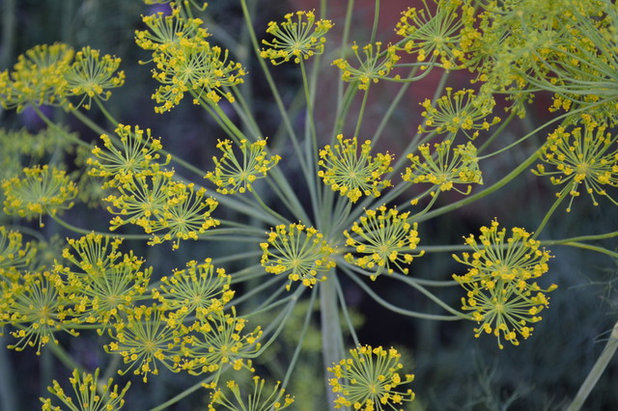Dill may be associated with pickles, but give it a try in other dishes as well. Both the new leaves and seeds are edible, and the blowsy foliage, delicate yellow flowers and 3-foot height (some varieties are shorter) add a delicate touch and some height to an herb garden. Dill is an annual, but it reseeds readily, so you're pretty much guaranteed more plants in the following years.
 Light requirement:
Light requirement: Full sun
Water requirement: Regular until established, then light
When to plant: Dill germinates more readily in spring, but you can sow through summer for a steady supply; in desert and mild-winter climates, continue planting through fall.
Favorites: Bouquet, Dukat, Fernleaf, Lady Diana, Smokey Bronze

Girasole Sonoma
Planting and CareIt's best to start from seeds, not transplants. Choose a site in full sun with well-drained, loose soil. Dill will do fine in rocky soil as long as the drainage is good and there is room for its long taproot to grow. Enrich very poor or compacted soil before planting. To avoid cross-pollination, plant well away from fennel and coriander.
Sow seeds ¼ inch deep in rows 2 feet apart. Thin seedlings to 1 foot apart when 2 to 3 inches tall. You can feed lightly in spring, if at all, but don’t overfertilize. To keep your crop going, sow successively throughout the growing season. If you're using containers, choose a pot at least 1 foot deep and wide and plant a more compact variety, such as Fernleaf.
Care is relatively easy. Dill doesn’t need constant water once established, thanks to its taproot, but dry weather can cause it to bolt. If you have a hot, dry spell, you’ll need to water more. Dill is heat sensitive, so even with your best efforts, the plants may die back in hot summer conditions.
Keep weeds under control. Pinch back the tops to keep the plants bushier and encourage new growth. You may need to stake taller plants, especially in windy areas.
Dill attracts butterflies and is also fairly pest free. You’re most likely to see caterpillars munching away for a short while. But these will turn into black swallowtail butterflies, so you’ll want them to leave them alone.
Dill readily reseeds. To prevent new plants from cropping up, shear off the flower heads.
 HarvestHarvest leaves when plants are 4 to 5 inches tall.
HarvestHarvest leaves when plants are 4 to 5 inches tall. Use fresh leaves for cooking until the flowers form; at that point you can harvest leaves to dry. Dry them in a cool location out of the sun. Leaves need to be completely dry before storing.
To collect seeds,
cut the flower stalks when the flower heads start to brown and hang them upside down. Tie a paper bag over the flower heads, poke air holes in the sides and leave in place for a week, then shake the flower heads to release the seeds into the bag and remove it, being careful not to spill the seeds on the ground. Let them dry in a warm and dry place.
Next: More herbs to grow at home





